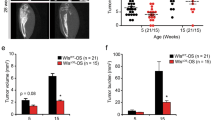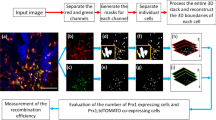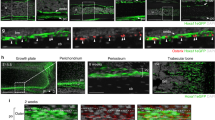Abstract
THE proto-oncogene c-fos is the cellular homologue of v-fos originally isolated from murine osteosarcoma1. Fos protein is a major component of the AP-1 transcription factor complex, which includes members of the jun family2. Stable expression of c-fos in mice has been demonstrated in developing bones and teeth, haematopoietic cells, germ cells and in the central nervous system3–11. It has been proposed that c-fos has an important role in signal transduction, cell proliferation and differentiation12–15. We have previously demonstrated that overexpression of c-fos in transgenic and chimaeric mice specifically affects bone, cartilage and haematopoietic cell development16–20. To understand better the function of c-fos in vivo, we used gene targeting in embryonic stem cells to generate cells and mice lacking c-fos. Here we report that heterozygous fos +/− mice appear normal, although females exhibit a distorted transmission frequency. All homozygous fos −/− mice are growth-retarded, develop osteopetrosis with deficiencies in bone remodelling and tooth eruption, and have altered haematopoiesis. These data define the c-Fos protein as an essential molecule for the development of specific cellular compartments.
This is a preview of subscription content, access via your institution
Access options
Subscribe to this journal
Receive 51 print issues and online access
$199.00 per year
only $3.90 per issue
Buy this article
- Purchase on Springer Link
- Instant access to full article PDF
Prices may be subject to local taxes which are calculated during checkout
Similar content being viewed by others
References
Finkel, J. P., Biskis, B. O. & Jinkins, P. B. Science 151, 698–701 (1966).
Angel, P. & Karin, M. Biochim. biophys. Acta 1072, 129–157 (1991).
Dony, C. & Gruss, P. Nature 328, 711–714 (1987).
De Togni, P., Niman, H., Raymond, V., Sawchenko, P. & Verma, I. M. Molec. cell. Biol. 8, 2251–2256 (1988).
Sandberg, M., Vuorio, T., Hirvonen, H., Alitalo, K. & Vuorio, E. Development 102, 461–470 (1988).
Caubet, J.-F. & Bernaudin, J.-F. Biol. Cell 64, 101–104 (1988).
Müller, R., Slamon, D. J., Tremblay, J. M., Cline, M. J. & Verma, I. M. Nature 299, 640–644 (1982).
Morgan, J. I., Cohen, D. R., Hempstead, J. L. & Curran, T. Science 237, 192–197 (1987).
Pelto-Huikko, M., Schultz, R., Koistinaho, J. & Hökfelt, T. Acta physiol. scand. 141, 283–284 (1991).
Smeyne, R. J. et al. Neuron 8, 13–23 (1992).
Cohen, D. R., Vandermark, S. E., McGovern, J. D. & Bradley, M. P. Oncogene (in the press).
Treisman, R. Cell 42, 889–902 (1985).
Bravo, R. in Growth Factors. Differentiation Factors and Cytokines (ed. Habenicht, A.) 324–343 (Springer, Berlin. 1990).
Morgan, J. I. & Curran, T. A. Rev. Neurosci. 14, 421–451 (1991).
Müller, R. & Wagner, E. F. Nature 311, 438–442 (1984).
Wang, Z.-Q., Grigoriadis, A. E., Möhle-Steinlein, U. & Wagner, E. F. EMBO J. 10, 2437–2450 (1991).
Rüther, U., Garber, C., Komitowski, D., Müller, R. & Wagner, E. F. Nature 325, 412–416 (1988).
Rüther, U., Komitowski, D., Schubert, F. R. & Wagner, E. F. Oncogene 4, 861–865 (1989).
Rüther, U. et al. Cell 53, 847–856 (1988).
Takao, S. et al. int. Immun. 3, 369–375 (1991).
Hilberg, F. & Wagner, E. F. Oncogene 7, 2371–2380 (1992).
Revell, P. A. Pathology of Bone (Springer, Berlin, 1986).
Green, M. C. in Genetic Variants and Strains of the Laboratory Mouse 2nd edn (eds Lyon, A. G. & Searle, A. G.) 12–403 (Oxford Univ. Press, Oxford, 1989).
Marks, S. C. Jr & Popoff, S. N. Am. J. Anat. 186, 325–334 (1989).
Soriano, P., Montgomery, C., Geske, R. & Bradley, A. Cell 64, 693–702 (1991).
Jones, K. L. Smith's Recognizable Patterns of Human Malformation 4th edn. 353–355 (Saunders, Philadelphia, 1988).
te Riele, H., Maandag, E. R., Clarke, A., Hooper, M. & Berns, A. Nature 348, 649–651 (1990).
Capecchi, M. R. Science 244, 1288–1292 (1989).
Doetschman, T. C., Eistetter, H., Katiz, M., Schmidt, W. & Kemler, R. J. Embryol. exp. Morphol. 87, 27–45 (1985).
Mortensen, R. M., Conner, D. A., Chao, S., Geisterfer-Lowrance, A. A. & Seidman, J. G. Molec. cell. Biol. 12, 2391–2395 (1992).
Author information
Authors and Affiliations
Rights and permissions
About this article
Cite this article
Wang, ZQ., Ovitt, C., Grigoriadis, A. et al. Bone and haematopoietic defects in mice lacking c-fos. Nature 360, 741–745 (1992). https://doi.org/10.1038/360741a0
Received:
Accepted:
Issue Date:
DOI: https://doi.org/10.1038/360741a0
This article is cited by
-
The chromosome-level genome and key genes associated with mud-dwelling behavior and adaptations of hypoxia and noxious environments in loach (Misgurnus anguillicaudatus)
BMC Biology (2023)
-
Human Macrophage- and Osteoclast-Based Constructs Do Not Induce Ectopic Bone Formation
Regenerative Engineering and Translational Medicine (2023)
-
Alternatively activated macrophages promote airway inflammation through JAK3–STAT5–Fra2 in asthma
Inflammation Research (2022)
-
Exogenous adenosine activates A2A adenosine receptor to inhibit RANKL-induced osteoclastogenesis via AP-1 pathway to facilitate bone repair
Molecular Biology Reports (2022)
-
Role of c-Fos in orthodontic tooth movement: an in vivo study using transgenic mice
Clinical Oral Investigations (2021)
Comments
By submitting a comment you agree to abide by our Terms and Community Guidelines. If you find something abusive or that does not comply with our terms or guidelines please flag it as inappropriate.



